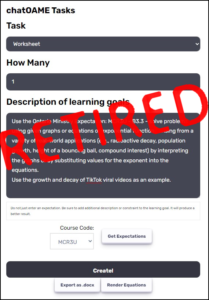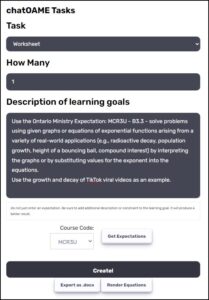Once we’re done the morning of math (with a brief coffee break) the teachers all get back together for an hour of math education pedagogy. Like the mathematics we cover, each year is something a little different. For example, in previous years we’ve focused on Lesson Design (with Drs. Nicole Bannister & Gail Burrill), Teaching through Problem Solving or Learning the Open-Ended Approach (with Dr. Akihiko Takahashi).
This year the organizers tried something a little different; they tapped six of the returning participants to look at Questioning in the Classroom from the practicing teachers’ perspective. As one of those teachers leading the professional development it was a considerable challenge to not only meet the expectations of the participants and the organizers but also our own expectations — my colleagues are amongst the premier educators in the States (National Board certified, AP consulants, you name it). We began with a working weekend in Denver in the spring, pulling together resources and a timeline — our biggest fight was avoiding putting too much in. And then, when actually talking about pedagogy with professional teachers there is a huge struggle against anecdotes; everyone wants to share their stories. In discussing Questioning we want to move beyond what we do now and move towards something better. And so we start with what the research said.
This blog post is only to set the scene for a series of posts; I will go into this at greater depths in the future but our motivation was the results of the 1999 TIMSS video study — James Hiebert presented the results to us in 2003 at PCMI and it was the most astonishing moment I’ve had in a lecture in a long time and it has been the prime motivator in my teaching ever since:
Almost all (ed: statistically 100%) of the problems in the U.S. that start out as making connections tasks are transformed, in a variety of ways. Often a teacher steps in and does the work for the students-sees students struggling, gives a hint that takes away the problematic nature of the lesson, and tells students how to solve it. These are not incompetent or poorly intentioned teachers but simply teachers who have picked up very well an American way of teaching mathematics. One of the cultural agreements we have made in this country, with ourselves as teachers and with students, is that it is the teacher’s job to tell students how to do the problem and how to get the right answer-that it is not fair to allow students to struggle or be confused.
 In other words: we are far too nice. So, for the past six years I have worked hard not to be nice and tried to persuade colleagues near and far to cowboy up1. I’ve presented on this at OAME directly and in any other presentation that I’ve done I’ve pressed the point. It was encouraging to see Dan Meyer come to a similar conclusion in his presentation to open source programmers (yes, the context is a bit bizarre but makes sense if you follow his blog). Be sure you should watch the video.
In other words: we are far too nice. So, for the past six years I have worked hard not to be nice and tried to persuade colleagues near and far to cowboy up1. I’ve presented on this at OAME directly and in any other presentation that I’ve done I’ve pressed the point. It was encouraging to see Dan Meyer come to a similar conclusion in his presentation to open source programmers (yes, the context is a bit bizarre but makes sense if you follow his blog). Be sure you should watch the video.![Reblog this post [with Zemanta]](http://img.zemanta.com/reblog_e.png?x-id=782540d7-170c-4b3b-ab39-5dca622d0703)
_________
1I include “cowboy up” only because I had to explain the phrase to Gail this year 🙂
Graph is created from data produced in the TIMSS video study and is from here: http://www.mathforum.com/pcmi/hstp/sum2009/reading/Hiebert_Improving_Math_Teaching_2004b.pdf


